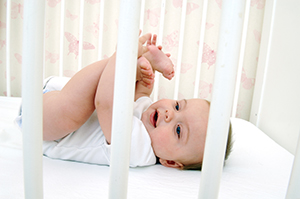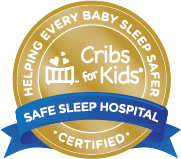Safe Sleeping for your Baby
 UM BWMC is committed to reducing Sudden Infant Death Syndrome (SIDS) and
providing education to new parents to keep babies safe and healthy. Safe
sleep practices are vitally important to reduce a baby's risk of SIDS and
other sleep-related causes of infant death.
UM BWMC is committed to reducing Sudden Infant Death Syndrome (SIDS) and
providing education to new parents to keep babies safe and healthy. Safe
sleep practices are vitally important to reduce a baby's risk of SIDS and
other sleep-related causes of infant death.
Parents, grandparents and caregivers of infants can use these key tips to ensure safe sleeping habits for your baby:
- Always place your baby on his or her back to sleep, for naps and at night. The back sleep position is the safest, and every sleep time counts.
- Place your baby on a firm sleep surface, such as on a safety-approved crib mattress, covered by a fitted sheet. Never place your baby to sleep on pillows, quilts, sheepskins, or other soft surfaces.
- Keep soft objects, toys, and loose bedding out of your baby's sleep area. Don't use pillows, blankets, quilts, sheepskins, or pillow-like crib bumpers in the baby's sleep area, and keep all objects away from your baby's face.
- Do not allow smoking around the baby. Don't smoke before or after the birth of your baby, and don't let others smoke in the house or around the baby.
- Keep your baby's sleep area close to, but separate from, where you and others sleep. Your baby should not sleep in a bed or on a couch or armchair with adults or other children, but he or she can sleep in the same room as you. If you bring your baby into bed with you to breastfeed, put him or her back in a separate sleep area, such as a bassinet, crib, or cradle when finished.
- Think about using a clean pacifier when placing the infant down to sleep, but don't force the baby to take it. If you are breastfeeding, wait until your child is 1 month old or breastfeeding is well established before using a pacifier.
- Do not let your baby overheat during sleep. Dress your baby in light sleep clothing, and keep the room at a temperature that is comfortable for an adult.
- Avoid purchasing or using products that claim to reduce the risk of SIDS because most have not been tested for effectiveness or safety.
- Do not use home monitors to reduce the risk of SIDS. If you have questions about using monitors for other conditions talk to your baby's health care provider.
- Reduce the chance that flat spots will develop on your baby's head: provide "Tummy Time" when your baby is awake and someone is watching him or her; alternate the baby's head position when he or she is placed to sleep so that the baby is not always sleeping on the same side of the head, change the direction that your baby lies in the crib from one week to the next (feet at one end of the crib one week, at the other end of the crib the next); hold the baby upright when he or she is not sleeping and limit the amount of time in car seats, carriers, and bouncers.
For more information on safe sleep, visit the website for Safe to Sleep®, a public education campaign led by NICHD - Eunice Kennedy Shriver National Institute of Child Health and Human Development.

